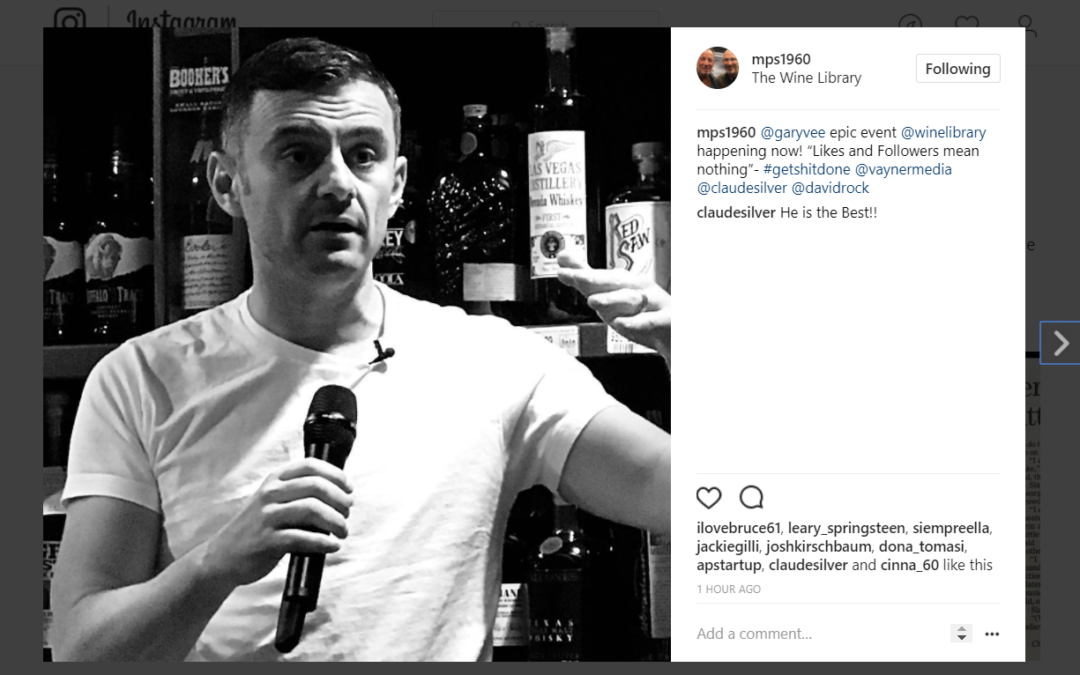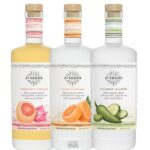Five years ago, I had a meeting with Gary Vaynerchuk to invite him to speak at a marketing conference for wine marketing professionals. We spoke of the attendees, their challenges and the opportunity to help them on their journey. He told me a story about storytelling. I never forgot that story.

Gary Vaynerchuk and Jeffrey Slater at The Wine Marketing Exchange
Gary told me about his Wine Library days how he used to look at the top 50 customers who bought the most from the business, and he would check out their profiles on Facebook and other social media outlets. He told me about one of his top customers was always posting about a professional athlete who played for the Chicago Bears named Jay Cutler. Gary’s customer admired this player and eighty percent of the content that this person posted online had to do with this athlete.
Gary purchased for him an autographed jersey of this player and sent it to him with a handwritten note thanking him for being great customers. No, upsell – no pushing a special deal. Just thank you. The shirt was expensive and hard to come by – but it meant more to Gary’s customer than anything in the world.
The story that Gary’s customer told online wasn’t about wine, but about an athlete. Gary figured out how to be an important part of that customer’s life by knowing that customer and paying attention to what matters to him. Gary didn’t need to tell him a story about Wine Library’s collection of Rhone Valley wines; he needed to show him that he sees him for what is important to him.
Here is a short video clip from this past weekend when Gary answered a question at Wine Library from my brother Mitch about great brands. His answer was spot on – as usual about understanding your brand’s audience. Gary knew that my brother Mitch is a super fan and historian of Bruce Springsteen and he knew that to understand my brother, he needed to understand his Bruce-centric world. BTW, follow Mitch on Twitter for all things Springsteen @mpslater.
Marketing – All about the story
Whether you work in B2B or B2C, uncovering the story that your customer wants to tell about themselves matters. Whether you uncover something about an individual or a group, brands can play a role in enabling a story to be told.
More than twenty years ago, in my Slim Jim days, I had the opportunity to bring together several marketing agencies and my marketing department to help us figure out how to leverage a critical insight we observed. We wanted to help young, teenage boys to free themselves from boredom. One of my colleagues described it that we needed to be the antidote to boredom and to help them with a little excitement. Slim Jim was the antidote and we needed to help the consumer tell a story about breaking free.
We gained this deep insight through qualitative research by understanding where the audience liked to hang out and what they enjoyed. From professional wrestling, grunge music, skateboarding to inner-city basketball, we spent time in their world observing our audience and found that if our brand could be a catalyst to breaking through the boredom, we could help them tell the story they wanted to tell.
Slim Jim refocused on being irreverent as it pushed back on convention. The brand moved away from being a “red-neck snack” toward providing platforms for excitement.
No one cared about the practical aspect of a portable protein snack. We didn’t talk about the ingredients except to make fun of them. Our consumers needed a little excitement, so we invited them to snap into a Slim Jim.
Three Practical Tips for Story Tellers
- Where can you go to hang out with the people you want to sell? You’ll learn more by being around them when they are playing, having fun and out in the world – then by staring at data and dashboards all day. Even if you can only be with one person in your target, hanging with them will be an invaluable insight into about how your brand might fit with their lives.
- Spend time watching movies, TV, video games and sporting events that your audience loves. Get a sense of what they love, what they hate and what’s important in their daily lives.
- Engage and listen. Find places to talk to potential customers not about your product and its benefits but about their lives and what’s going on in their world. Use your empathic superpowers to be present and to connect with their challenges.
Brands no longer get to tell stories. Brands need to help provide opportunities for your customer’s own story to unfold.
What story are you helping your customer’s tell?
Listen to some of Gary’s prescient comments from 2011 about wine marketing here. Need help with your brand’s storytelling – email me at jeffslater@themarketingsage.com or call me at 919 720 0995.
Photo courtesy Mitchell Slater




